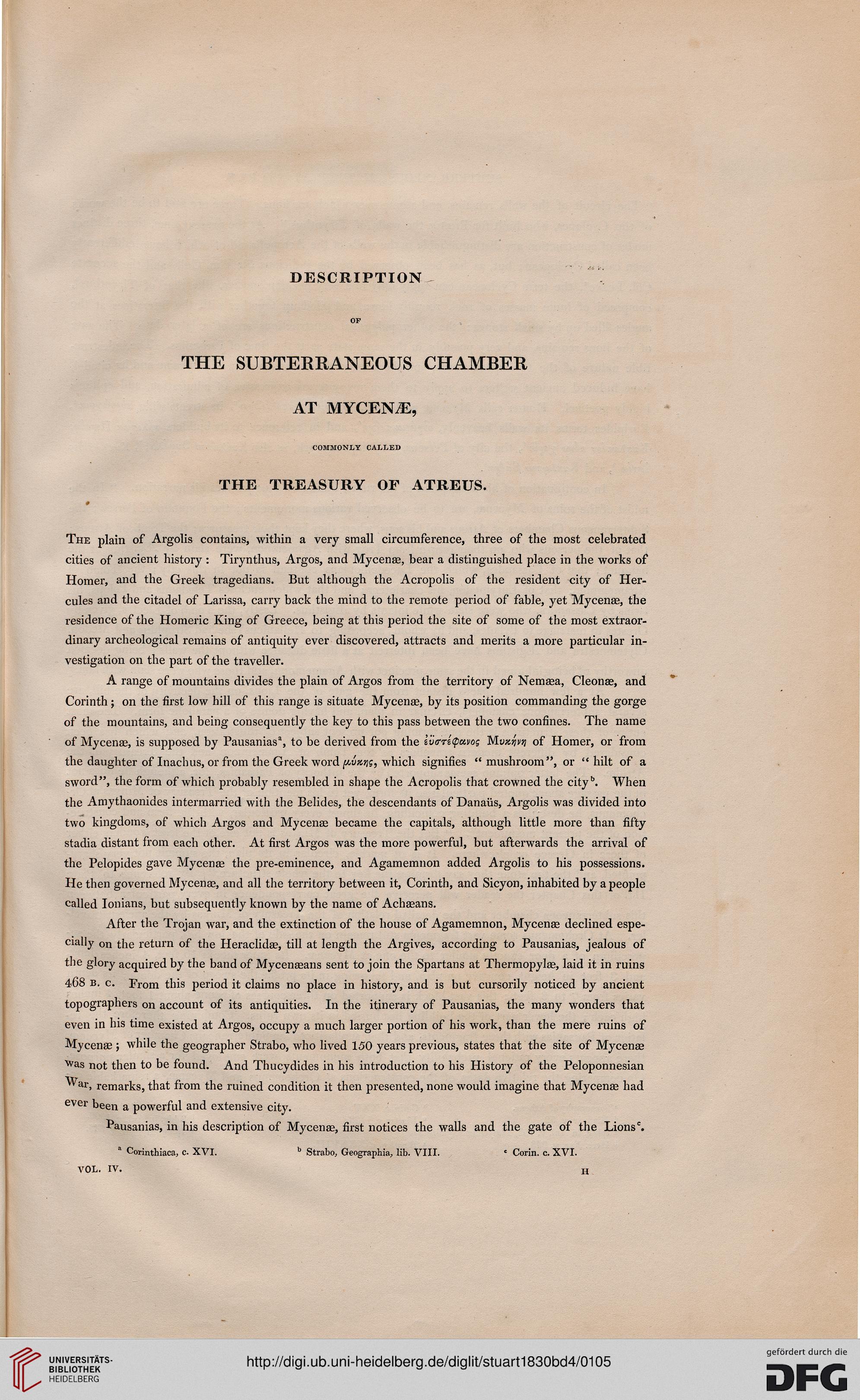DESCRIPTION
OF
THE SUBTERRANEOUS CHAMBER
AT MYCEN.E,
COMMONLY CALLED
THE TREASURY OF ATREUS.
The plain of Argolis contains, within a very small circumference, three of the most celebrated
cities of ancient history : Tirynthus, Argos, and Mycenae, bear a distinguished place in the works of
Homer, and the Greek tragedians. But although the Acropolis of the resident city of Her-
cules and the citadel of Larissa, carry back the mind to the remote period of fable, yet Mycenae, the
residence of the Homeric King of Greece, being at this period the site of some of the most extraor-
dinary archeological remains of antiquity ever discovered, attracts and merits a more particular in-
vestigation on the part of the traveller.
A range of mountains divides the plain of Argos from the territory of Nemaea, Cleonae, and
Corinth; on the first low hill of this range is situate Mycenae, by its position commanding the gorge
of the mountains, and being consequently the key to this pass between the two confines. The name
of Mycenae, is supposed by Pausanias3, to be derived from the 2va-rs(pavog Mra^^ of Homer, or from
the daughter of Inachus, or from the Greek word fAiwrig, which signifies "mushroom", or "hilt of a
sword", the form of which probably resembled in shape the Acropolis that crowned the city\ When
the Amythaonides intermarried with the Belides, the descendants of Danaiis, Argolis was divided into
two kingdoms, of which Argos and Mycenae became the capitals, although little more than fifty
stadia distant from each other. At first Argos was the more powerful, but afterwards the arrival of
the Pelopides gave Mycenae the pre-eminence, and Agamemnon added Argolis to his possessions.
He then governed Mycenae, and all the territory between it, Corinth, and Sicyon, inhabited by a people
called Ionians, but subsequently known by the name of Achaeans.
After the Trojan war, and the extinction of the house of Agamemnon, Mycenae declined espe-
cially on the return of the Heraclidae, till at length the Argives, according to Pausanias, jealous of
the glory acquired by the band of Mycenaeans sent to join the Spartans at Thermopylae, laid it in ruins
468 b. c. From this period it claims no place in history, and is but cursorily noticed by ancient
topographers on account of its antiquities. In the itinerary of Pausanias, the many wonders that
even in his time existed at Argos, occupy a much larger portion of his work, than the mere ruins of
Mycenae ; while the geographer Strabo, who lived 150 years previous, states that the site of Mycenae
was not then to be found. And Thucydides in his introduction to his History of the Peloponnesian
War> remarks, that from the ruined condition it then presented, none would imagine that Mycenae had
ever been a powerful and extensive city.
Pausanias, in his description of Mycenae, first notices the walls and the gate of the Lions0.
Corinthiaca, c XVI.
Strabo, Geographia, lib. VIII.
■ Corin. c. XVI.
VOL. IV.
H
OF
THE SUBTERRANEOUS CHAMBER
AT MYCEN.E,
COMMONLY CALLED
THE TREASURY OF ATREUS.
The plain of Argolis contains, within a very small circumference, three of the most celebrated
cities of ancient history : Tirynthus, Argos, and Mycenae, bear a distinguished place in the works of
Homer, and the Greek tragedians. But although the Acropolis of the resident city of Her-
cules and the citadel of Larissa, carry back the mind to the remote period of fable, yet Mycenae, the
residence of the Homeric King of Greece, being at this period the site of some of the most extraor-
dinary archeological remains of antiquity ever discovered, attracts and merits a more particular in-
vestigation on the part of the traveller.
A range of mountains divides the plain of Argos from the territory of Nemaea, Cleonae, and
Corinth; on the first low hill of this range is situate Mycenae, by its position commanding the gorge
of the mountains, and being consequently the key to this pass between the two confines. The name
of Mycenae, is supposed by Pausanias3, to be derived from the 2va-rs(pavog Mra^^ of Homer, or from
the daughter of Inachus, or from the Greek word fAiwrig, which signifies "mushroom", or "hilt of a
sword", the form of which probably resembled in shape the Acropolis that crowned the city\ When
the Amythaonides intermarried with the Belides, the descendants of Danaiis, Argolis was divided into
two kingdoms, of which Argos and Mycenae became the capitals, although little more than fifty
stadia distant from each other. At first Argos was the more powerful, but afterwards the arrival of
the Pelopides gave Mycenae the pre-eminence, and Agamemnon added Argolis to his possessions.
He then governed Mycenae, and all the territory between it, Corinth, and Sicyon, inhabited by a people
called Ionians, but subsequently known by the name of Achaeans.
After the Trojan war, and the extinction of the house of Agamemnon, Mycenae declined espe-
cially on the return of the Heraclidae, till at length the Argives, according to Pausanias, jealous of
the glory acquired by the band of Mycenaeans sent to join the Spartans at Thermopylae, laid it in ruins
468 b. c. From this period it claims no place in history, and is but cursorily noticed by ancient
topographers on account of its antiquities. In the itinerary of Pausanias, the many wonders that
even in his time existed at Argos, occupy a much larger portion of his work, than the mere ruins of
Mycenae ; while the geographer Strabo, who lived 150 years previous, states that the site of Mycenae
was not then to be found. And Thucydides in his introduction to his History of the Peloponnesian
War> remarks, that from the ruined condition it then presented, none would imagine that Mycenae had
ever been a powerful and extensive city.
Pausanias, in his description of Mycenae, first notices the walls and the gate of the Lions0.
Corinthiaca, c XVI.
Strabo, Geographia, lib. VIII.
■ Corin. c. XVI.
VOL. IV.
H




